Freer and Ackler Galleries of Art Freer and Sackler Galleries of Art Designer
 | |
| Established | 1923 |
|---|---|
| Location | 1050 Independence Artery Washington, D.C. |
| Coordinates | 38°53′17″N 77°01′39″West / 38.888135°North 77.02739°W / 38.888135; -77.02739 Coordinates: 38°53′17″N 77°01′39″West / 38.888135°N 77.02739°Westward / 38.888135; -77.02739 |
| Director | Chase F. Robinson |
| Public transit access | |
| Website | world wide web.asia.si.edu |
| Freer Gallery Of Art | |
| U.S. National Register of Historic Places | |
| U.Southward. National Historic Landmark | |
 Front archway to the Freer Gallery of Fine art | |
| Congenital | 1923 |
| Architect | Platt, Charles A. |
| Architectural style | Late 19th And 20th Century Revivals, Florentine Renaissance |
| NRHP referenceNo. | 69000295[i] |
| Added to NRHP | June 23, 1969 |
The Freer Gallery of Fine art is an fine art museum of the Smithsonian Establishment in Washington, D.C. focusing on Asian art. The Freer and the Arthur M. Sackler Gallery together class the Smithsonian's national museums of Asian fine art in the Us. The Freer and Sackler galleries house the largest Asian art research library in the country and contain art from East Asia, South Asia, Southeast Asia, the Islamic world, the aboriginal Near East, and ancient Arab republic of egypt, besides as a significant collection of American fine art.
The gallery is located on the southward side of the National Mall in Washington, D.C., contiguous with the Sackler Gallery. The museum is open 364 days a year (being closed on Christmas), and is administered by a unmarried staff with the Sackler Gallery. The galleries were amid the near visited fine art museums in the world.
The Freer houses over 26,000 objects spanning 6,000 years of history from the Neolithic to modernistic eras. The collections include ancient Egyptian stone sculpture and wooden objects, ancient Near Eastern ceramics and metalware, Chinese paintings and ceramics, Korean pottery and porcelain, Japanese folding screens, Farsi manuscripts, and Buddhist sculpture. In add-on to Asian art, the Freer besides contains the famous Harmony in Blue and Aureate: The Peacock Room (better known equally The Peacock Room) past American artist James McNeill Whistler which serves as the centerpiece to the Freer'due south American art collection.
The museum offers free tours to the public and presents a full schedule events for the public including films, lectures, symposia, concerts, performances, and discussions. Over 11,000 objects from the Freer|Sackler collections are fully searchable and bachelor online.[two] The Freer was besides featured in the Google Fine art Project, which offers online viewers close-upward views of selected items from the Freer.[3]
History [edit]
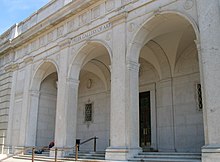
Archway to the Freer Gallery of Art
Founding [edit]
The gallery was founded by Detroit railroad-auto manufacturer and self-taught connoisseur Charles Lang Freer. He endemic the largest collection of works by American artist James McNeill Whistler (1834-1903) and became a patron and friend of the famously irascible artist. Whistler made it very clear to Freer that if he helped him to build the premier Whistler drove, then that collection would have to be displayed in a city where tourists went.[4]
In 1908, Charles Moore, a old aide to Michigan United States Senator, James McMillin and the chairman of the United States Committee of Fine Arts, moved from Washington, D.C., to Detroit. Moore became friends with Freer, who was manager of the Michigan Auto Company, and persuaded Freer to permanently exhibit his 8,000-piece drove of Oriental art in Washington, D.C. Before then, Freer informally proposed to President Theodore Roosevelt that he requite to the nation his art collection, funds to construct a edifice, and an endowment fund to provide for the study and acquisition of "very fine examples of Oriental, Egyptian, and Near Eastern fine arts."[v]
The Freer gift was accepted on behalf of the authorities by the Smithsonian Board of Regents in 1906. Freer'due south will, nevertheless, contained certain requirements that only objects from the permanent collection could exist exhibited in the gallery, and that none of the fine art could exist exhibited elsewhere. Freer felt strongly that all of the museum'southward holding should be readily accessible to scholars at all times. In addition, Freer'south bequest to the Smithsonian came with the proviso that he would execute full curatorial control over the drove until his death. The Smithsonian initially hesitated at the requirements but the intercession of President Theodore Roosevelt immune for the project to proceed. The Freer Gallery possesses an autographed letter from Roosevelt inviting Freer to visit him at the White House, reflecting the personal interest Roosevelt showed in the development of the museum. Freer died before the art gallery was completed.[ citation needed ]
Construction and architecture [edit]
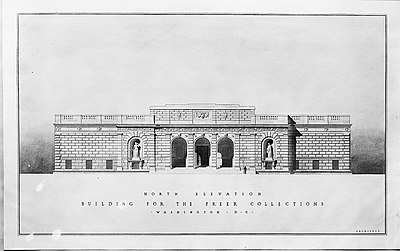
Construction of the gallery began in 1916 and was completed in 1921, later on a delay due to Earth War I.[half-dozen] On May 9, 1923, the Freer Gallery of Art was opened to the public. Designed by American builder and landscape planner Charles A. Platt, the Freer is an Italian Renaissance-style edifice inspired by Freer'due south visits to palazzos in Italy.[vii] It is reported that in a meeting with architect Charles Platt at the Plaza Hotel in New York City, Freer jotted downward his ideas for a classical, well-proportioned building on a napkin.[8] The gallery is synthetic primarily of granite: the exterior of the Freer is pink granite quarried in Milford, Massachusetts, the courtyard has a carnelian granite fountain and walls of unpolished Tennessee white marble. The gallery'due south interior walls are Indiana limestone, and the floors are polished Tennessee marble.[ citation needed ]
A major renovation of the building, which culminated in a grand reopening in 1993, profoundly expanded storage and exhibition infinite by connecting the Freer and the Arthur M. Sackler Gallery. With the addition of the connecting gallery, the Freer has 39,039 square feet (3,626.eight m2) of public space. The original structure designed by Platt remains intact, including the Eugene and Agnes E. Meyer Auditorium which serves as the venue for many public programs.[ citation needed ]
Current [edit]
Afterward opening in 1923, the Freer served every bit the Smithsonian's first museum dedicated to the fine arts.[9] The Freer was too the commencement Smithsonian museum created from a private collector's heritance. Through the years, the collections take grown through gifts and purchases to well-nigh triple the size of Freer's original donation: nearly 18,000 works of Asian art have been added since Freer's death in 1919.[ citation needed ]
The Freer is now connected by an underground exhibition space to the neighboring Arthur M. Sackler Gallery. Although their collections are stored and exhibited separately, the two museums share a manager, administration, and staff. The Freer closed for all-encompassing renovations in January 2016 and reopened in October 2017.[10]
Exhibitions [edit]
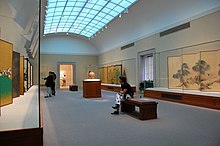
Because ane of the master conditions of Charles Lang Freer donation stated that merely items from his collection may be exhibited at the gallery, the Freer does not borrow from or lend out items to other institutions. Nonetheless, due to the 26,000 objects in the gallery's collections, they are withal able to present exhibitions internationally recognized for both depth and quality.
The Freer also has a number of rotating/temporary exhibits.
American art at the Freer [edit]
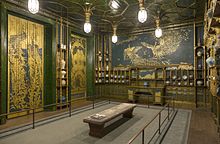
The Peacock Room by Whistler
Freer began collecting American fine art in the 1880s.[8] In 1890, after meeting James Abbott McNeill Whistler, an American artist influenced past Japanese prints and Chinese ceramics, Freer began to expand his collections to include Asian art. He maintained his interest in American art, however, amassing a collection of over ane,300 works by Whistler, which is considered the world's finest.[ commendation needed ]
I of the most well-known exhibits at the Freer is The Peacock Room, an opulent London dining room painted by Whistler in 1876–77. The room was designed for British shipping magnate F.R. Leyland[11] and is lavishly busy with green and gilt peacock motifs. Purchased by Freer in 1904 and installed in the Freer Gallery afterwards his death, The Peacock Room is on permanent brandish.[ commendation needed ]
The Freer also has works by Thomas Dewing (1851–1938), Dwight Tryon (1849–1925), Abbott Handerson Thayer (1849–1921), Childe Hassam (1859–1935), Winslow Homer (1836–1910), Augustus Saint-Gaudens (1848–1907), Willard Metcalf (1858–1925), John Singer Sargent (1856–1925), and John Twachtman (1853–1902).[12]
F|S Online [edit]
The Freer|Sackler provides several online resources for exploring the art and civilisation of Asia and its American art collections. Besides the collections objects viewable online, thousands of photographs, archeological diaries, maps, and archaeological squeezes (impressions of carvings) take been digitized and are used by researchers from around the world.
F|S Archives and Library [edit]
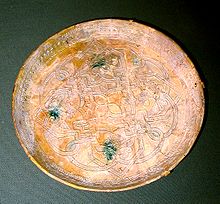
This earthenware dish from 9th century Abbasid, Iraq is one of the many artifacts exhibited at the Freer Gallery.
The Freer Sackler Archives[13] houses over 120 important manuscripts collections relevant to the report of America'southward meet with Asian art and culture. The cadre drove is the personal papers of gallery founder Charles Lang Freer, which includes his purchase records, diaries, and personal correspondence with public figures such every bit artists, dealers and collectors. Freer'due south all-encompassing correspondence with James McNeill Whistler forms one of the largest sources of primary documents near the American artist. Other meaning collections in the Archives includes the papers (notebooks, letters, photography, squeezes) and personal objects of the German archaeologist Ernst Herzfeld (1879–1946), documenting his research at Samarra, Persepolis and Pasargadae. The papers of Carl Whiting Bishop[14] Dwight William Tryon, Myron Bement Smith,[15] Benjamin March[16] and Henri Vever[17] are too located at the Archives. The Archives also holds over 125,000 photographs of Asia dating from the 19th and early on 20th centuries. Highlights of photographic holdings include the Henry and Nancy Rosin Drove of 19th century photography of Japan,[eighteen] the 1903-1904 photographs of the Chinese Empress Dowager Cixi, and photographs of Iran by Antoin Sevruguin.[xix]
The Freer|Sackler Library is the largest Asian fine art research library in the United States. Open to the public 5 days a week (except federal holidays) without date, the library drove consists of more than than 86,000 volumes, including nearly 2,000 rare books. Half the volumes are written and catalogued in Asian languages. Originating from the collection of four k monographs, periodical issues, offprints, and sales catalogues that Charles Lang Freer donated to the Smithsonian Establishment as office of his souvenir to the nation, the F|S Library maintains the highest standards for collecting materials an active program of purchases, gifts, and exchanges.[ citation needed ]
In July 1987 the library moved to its new dwelling house in the Arthur 1000. Sackler Gallery. Today it supports activities of both museums, such equally collection development, exhibition planning, publications, and other scholarly and educational projects. Its published and unpublished resource—in the fields of Asian art and archaeology, conservation, painting, sculpture, architecture, drawings, prints, manuscripts, books, and photography—are available to museum staff, exterior researchers, and the visiting public.[ commendation needed ]
Public programs [edit]
The Eugene and Agnes E. Meyer Auditorium, named after American financier and publisher Eugene Meyer and journalist/social activist Agnes Eastward. Meyer, is located in the Freer and provides a venue for a broad multifariousness of free public programs. These programs include concerts of music and dance, lectures, chamber music, and dramatic presentations. Information technology is likewise known for its film series, highlighting a wide diverseness of Asian cultures (including a Korean Picture Festival and Iranian Film Festival).[ citation needed ]
Most recently, the museums began the series Asia After Nighttime, opening upward the space for musicians, dancing, Asian cuisine, and other after-work adventures. The Freer and Sackler'southward 'We Stand up With Nippon' in 2011 hosted Steve Aoki.[xx]
Free drib-in tours are available daily and guide visitors through both featured exhibitions and specific themes in both the Freer and Sackler galleries, and a wide range of public lectures provide in-depth experiences with prominent artists and scholars.[ citation needed ]
Conservation [edit]
Care of the collections began before the museum came into existence equally Charles Lang Freer, the founder of the Freer Gallery of Art, hired Japanese painting restorers to care for his works and to prepare them for their eventual home equally part of the Smithsonian Institution. In 1932, the Freer Gallery of Art hired a full-time Japanese restorer and established what was to go the East Asian Painting Conservation Studio. This facility remains one of the few in the U.s. that specializes in the conservation of Asian paintings.[six] The Technical Laboratory was established in 1951 when chemist Rutherford J. Gettens moved from the Fogg Museum at Harvard University to the Freer. The laboratory was the start Smithsonian facility devoted to the use of scientific methods for the study of works of art. Over the years, the work of the Technical Laboratory expanded to include objects, paper, and exhibits conservation. The Technical Laboratory and the East Asian Painting Conservation Studio merged in 1990 to create the Department of Conservation and Scientific Inquiry for both the Freer and Sackler Galleries.[21]
The conservators in the Section of Conservation and Scientific Inquiry care for and care for works of art in the collection and prepare them for exhibition. The department works to ensure long-term preservation and storage, safe handling, exhibition, and transport of artworks in the permanent collection, as well as those on loan. In improver, conservators are responsible for conducting technical examinations of objects already in the collection and those under consideration for acquisition. They besides interact frequently with the department'due south scientists on technical and applied research. Grooming and professional person outreach efforts are an integral part of the department's commitment to educating future conservators, museum professionals, and the public about conservation.[ citation needed ]
Scholarship [edit]
The Freer has had a long tradition in serving as a center for inquiry and advanced scholarship about Asia. The Freer not only presents lectures and symposia to the public, but it also copublishes the Ars Orientalis with the University of Michigan Section of History of Art. Ars Orientalis is a peer-reviewed annual volume of scholarly articles and occasional reviews of books on the art and archaeology of Asia, the aboriginal Well-nigh East, and the Islamic earth.[22] [23]
The Freer and Sackler, along with the Metropolitan Center for Far Eastern Art Studies in Kyoto, Japan, presents the Shimada Prize for distinguished scholarship in the history of Due east Asian fine art. The award was established in 1992 in honor of Professor Shimada Shujiro, by the Freer Gallery of Art and Arthur M. Sackler Gallery and by The Metropolitan Center for Far Eastern Fine art Studies in Kyoto, Japan. Several fellowships are also available to back up graduate students and visiting scholars, including the Andrew W. Mellon Fellowship, Anne Van Biema Fellowship (Japanese Visual Arts), Islamic republic of iran Heritage Foundation (IHF) Fellowship (Persian art), Lunder Fellowship, J. Southward. Lee Memorial Fellowship (Chinese Art), Smithsonian Institution Fellowship, and the Freer Fellowship.[24]
Freer and Sackler curators are too involved in dozens of ongoing research projects, oftentimes with colleagues from institutions around the globe. The results of their piece of work tin can be seen in a variety of published formats, including exhibition catalogues, scholarly publications, and online publications.[25]
Gallery [edit]
China [edit]
India [edit]
-

Seated Ganesha, Hoysala dynasty, 12th–13th century
-

Sri Krsna with the flute Opaque watercolor and gold
-

Depiction of the Lord Krishna in the Gilt City from the Harivamsha
-
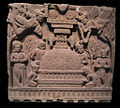
The Bharhut stupa, depicted on one of the friezes.
Egypt [edit]
-

Ancient Egyptian coffin mask made of wood and glass, New Kingdom, 18th or 19th Dynasty (1550–1196 BC)
-

Ancient Egyptian miniature glassware vessels, New Kingdom, 18th Dynasty (1550–1307 BC)
Japan [edit]
Nepal [edit]
Persia [edit]
Korea [edit]
Syria [edit]
Kushan [edit]
See also [edit]
- Biblical Manuscripts in the Freer Drove
- Chinese painting
- History of art
- History of painting
- Indian art
- Islamic fine art
- Japanese painting
- Pewabic Pottery
- Ernst Herzfeld and Persepolis
- Zhou Jichang
- Charles Lang Freer medal
- Lin Tinggui
- J. Keith Wilson
References [edit]
- ^ "National Register Information System". National Annals of Celebrated Places. National Park Service. March 13, 2009.
- ^ "Collections | Freer and Sackler Galleries". Asia.si.edu. 2013-03-15. Retrieved 2014-06-06 .
- ^ "Freer|Sackler: The Smithsonian's Museums of Asian Art - Google Cultural Institute". Googleartproject.com. Retrieved 2014-06-06 .
- ^ Linda Merrill, a former curator of American art at the Freer Gallery, editor of With Kindest Regards: The Correspondence of Charles Lang Freer and James McNeill Whistler, and co-author of Freer: A Legacy of Art.
- ^ Smithsonian Establishment Archives
- ^ a b Smithsonian Institution Archives
- ^ Caemmerer, H. Paul. "Charles Moore and the Plan of Washington." Records of the Columbia Historical Society. Vol. 46/47 (1944/1945): 237-258, 256.
- ^ a b "Charles Lang Freer | About U.s. | Freer and Sackler Galleries". Asia.si.edu. 2013-03-15. Archived from the original on 2011-12-31. Retrieved 2014-06-06 .
- ^ "The Freer Gallery of Fine art | About The states | Freer and Sackler Galleries". Asia.si.edu. 2013-03-15. Archived from the original on 2014-08-26. Retrieved 2014-06-06 .
- ^ "Freer Gallery of Fine art To Reopen After Most 2 Years". newsdesk.si.edu. Smithsonian. 11 October 2017. Retrieved 4 March 2018.
- ^ "A Closer Await - James McNeill Whistler - Peacock Room". Asia.si.edu. Retrieved 2014-06-06 .
- ^ "Freer and Sackler Galleries | Collections". Asia.si.edu. 2013-03-15. Retrieved 2014-06-06 .
- ^ "Athenaeum - Freer-Sackler".
- ^ Bishop, Carl Whiting. "The Carl Whiting Bishop Collection" – via siris-archives.si.edu Library Catalog.
- ^ Smith, Myron Bement. "Myron Bement Smith Collection" – via siris-athenaeum.si.edu Library Catalog.
- ^ "Benjamin March - A Finding Aid to His Papers at the Freer Gallery of Art and Arthur M. Sackler Gallery Archives".
- ^ "Henri Vever - A Finding Assistance to His Papers at the Freer Gallery of Art and Arthur M. Sackler Gallery Archives". Archived from the original on 2013-08-05. Retrieved 2011-01-31 .
- ^ Rosin, Henry D.; Lyman, Benjamin Smith; Ueno, Hikoma; Beato, Felice; Rosin, Nancy; Stillfried, Raimund. "Henry and Nancy Rosin Drove of Early Photography of Japan" – via siris-archives.si.edu Library Catalog.
- ^ "Archives: Highlights | Freer and Sackler Galleries". Asia.si.edu. 2013-03-15. Retrieved 2014-06-06 .
- ^ "Asia Later on Dark - Freer Gallery of Fine art - We Stand up with Nihon | Flickr - Photo Sharing!". Flickr. 2011-05-14. Retrieved 2014-06-06 .
- ^ [one] Archived February 2, 2007, at the Wayback Motorcar
- ^ "Ars Orientalis Freer and Sackler Galleries". Asia.si.edu. 2013-03-xv. Retrieved 2014-06-06 .
- ^ "Ars Orientalis". Freer/Sackler. Retrieved March 20, 2019.
- ^ "Fellowships & Internships | Research | Freer and Sackler Galleries". Asia.si.edu. 2013-03-15. Retrieved 2014-06-06 .
- ^ "Curatorial Enquiry | Freer and Sackler Galleries". Asia.si.edu. 2013-03-15. Retrieved 2014-06-06 .
External links [edit]
![]() Media related to Freer Gallery of Art at Wikimedia Commons
Media related to Freer Gallery of Art at Wikimedia Commons
- Freer Gallery of Fine art and the Arthur M. Sackler Gallery
Source: https://en.wikipedia.org/wiki/Freer_Gallery_of_Art








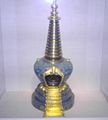















0 Response to "Freer and Ackler Galleries of Art Freer and Sackler Galleries of Art Designer"
Post a Comment